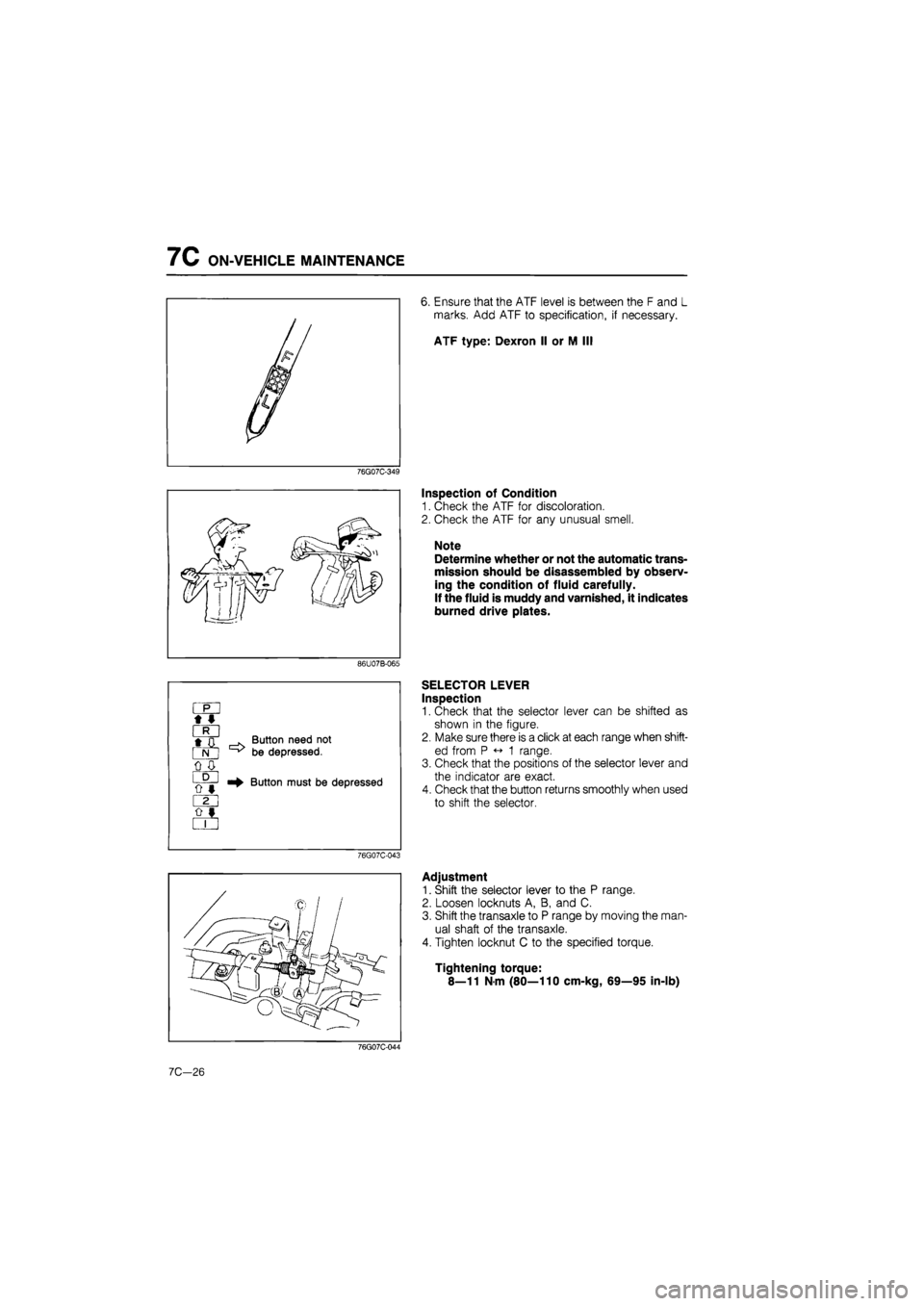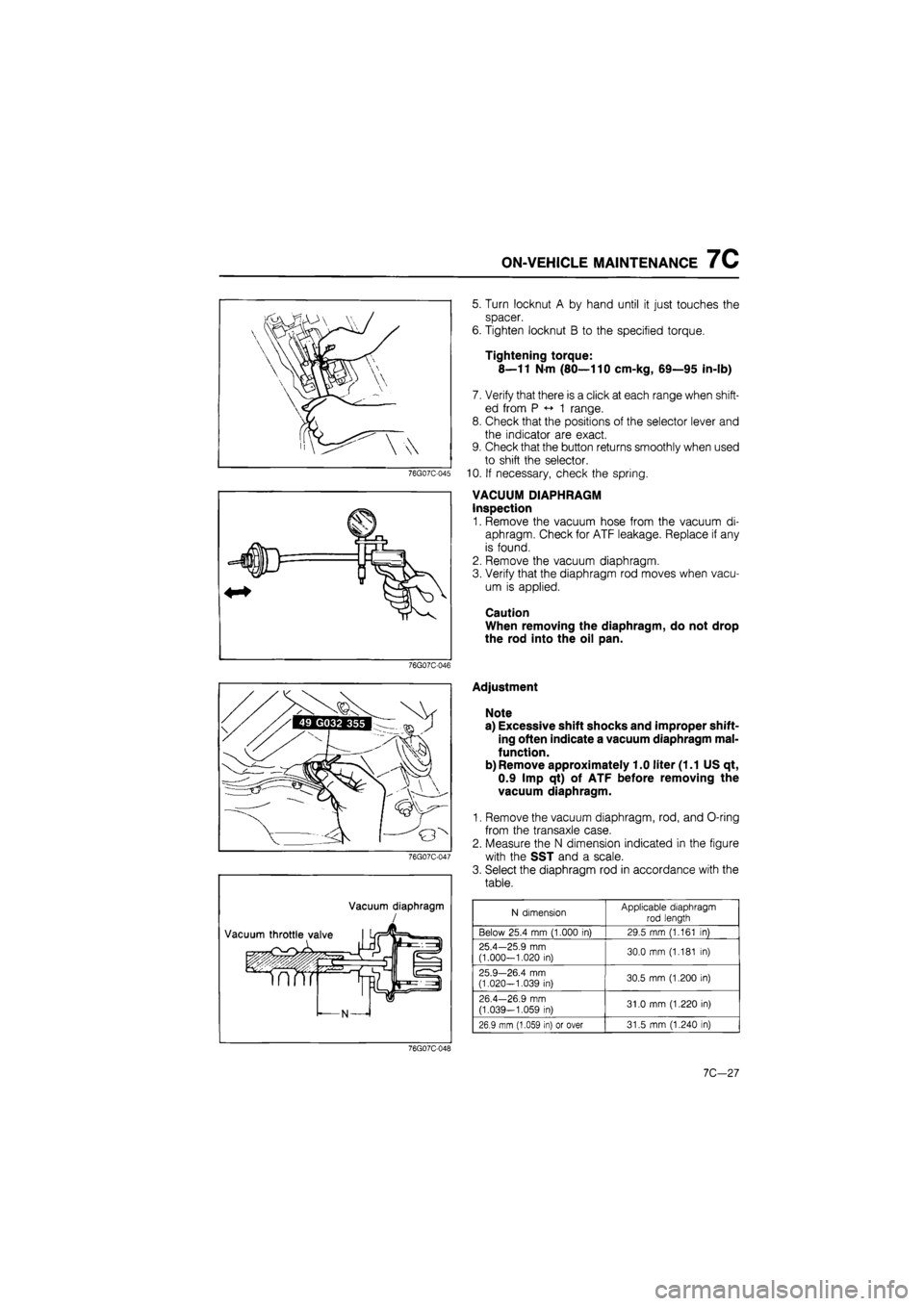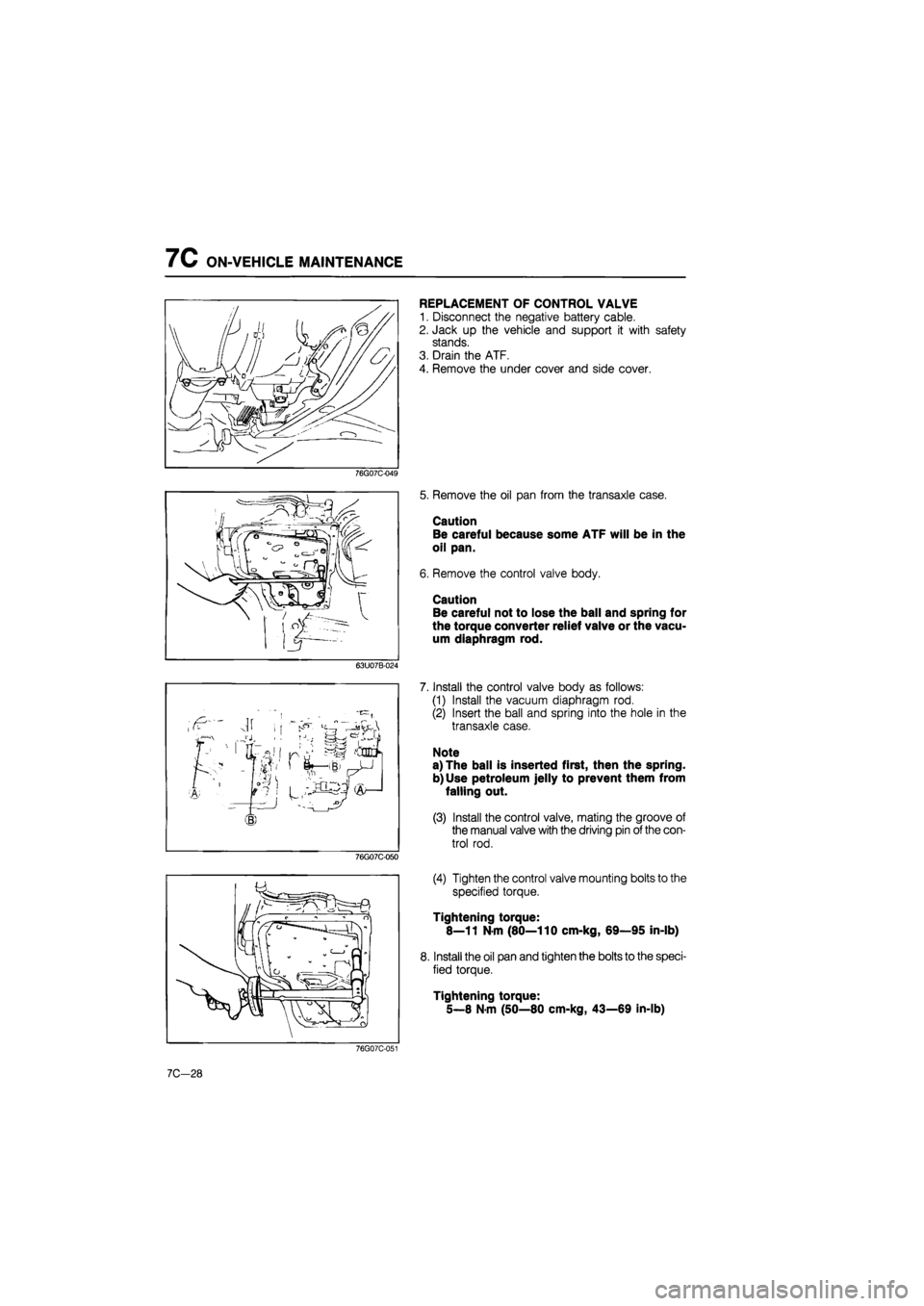Page 1130 of 1865
7C TROUBLESHOOTING
Evaluation
Condition Possible cause
Worn oil pump
In all ranges Insufficient line
pressure
Oil leakage from oil pump, control
valve, and/or transaxle case
Stuck pressure regulator valve
In D, 2, and 1 Rear clutch slipping
Above specification In D range only One-way clutch slipping
In 2 range only Brake band slipping
Low and reverse brake slipping
Brake band slipping
In R range only Road test to determine if cause is low and reverse brake or reverse clutch:
a) Engine braking in 1 range Front clutch b) No engine braking in 1 range .... Low and reverse brake
Within specification All shift control elements within transaxle functioning normally
Below specification Engine out of tune Below specification
One-way clutch slipping within torque converter
76G07C-026
7C—16
Page 1140 of 1865

7C ON-VEHICLE MAINTENANCE
76G07C-349
[ff/A rm \ I
86U07B-065
« I
•D
cS
o 0
m 0 «
o «
. Button need not
^ be depressed.
Button must be depressed
76G07C-043
6. Ensure that the ATF level is between the F and L
marks. Add ATF to specification, if necessary.
ATF type: Dexron II or M II!
Inspection of Condition
1. Check the ATF for discoloration.
2. Check the ATF for any unusual smell.
Note
Determine whether or not the automatic trans-
mission should be disassembled by observ-
ing the condition of fluid carefully.
If the fluid is muddy and varnished, it indicates
burned drive plates.
SELECTOR LEVER
Inspection
1. Check that the selector lever can be shifted as
shown in the figure.
2. Make sure there is a click at each range when shift-
ed from P <-• 1 range.
3. Check that the positions of the selector lever and
the indicator are exact.
4. Check that the button returns smoothly when used
to shift the selector.
Adjustment
1. Shift the selector lever to the P range.
2. Loosen locknuts A, B, and C.
3. Shift the transaxle to P range by moving the man-
ual shaft of the transaxle.
4. Tighten locknut C to the specified torque.
Tightening torque:
8—11 N-m (80—110 cm-kg, 69—95 in-lb)
76G07C-044
7C-26
Page 1141 of 1865

ON-VEHICLE MAINTENANCE 7C
76G07C-045
fflfiirv T
5. Turn locknut A by hand until it just touches the
spacer.
6. Tighten locknut B to the specified torque.
Tightening torque:
8—11 N-m (80—110 cm-kg, 69—95 in-lb)
7. Verify that there is a click at each range when shift-
ed from P «-» 1 range.
8. Check that the positions of the selector lever and
the indicator are exact.
9. Check that the button returns smoothly when used
to shift the selector.
10. If necessary, check the spring.
VACUUM DIAPHRAGM
Inspection
1. Remove the vacuum hose from the vacuum di-
aphragm. Check for ATF leakage. Replace if any
is found.
2. Remove the vacuum diaphragm.
3. Verify that the diaphragm rod moves when vacu-
um is applied.
Caution
When removing the diaphragm, do not drop
the rod into the oil pan.
76G07C-046
Vacuum diaphragm
Adjustment
Note
a) Excessive shift shocks and improper shift-
ing often indicate a vacuum diaphragm mal-
function.
b) Remove approximately 1.0 liter (1.1 US qt,
0.9 Imp qt) of ATF before removing the
vacuum diaphragm.
1. Remove the vacuum diaphragm, rod, and O-ring
from the transaxle case.
2. Measure the N dimension indicated in the figure
with the SST and a scale.
3. Select the diaphragm rod in accordance with the
table.
N dimension Applicable diaphragm
rod length
Below 25.4 mm (1.000 in) 29.5 mm (1.161 in)
25.4—25.9 mm (1.000-1.020 in) 30.0 mm (1.181 in)
25.9—26.4 mm (1.020-1.039 in) 30.5 mm (1.200 in)
26.4—26.9 mm
(1.039—1.059 in) 31.0 mm (1.220 in)
26.9 mm (1.059 in) or over 31.5 mm (1.240 in)
76G07C-048
10,-21
Page 1142 of 1865

7C ON-VEHICLE MAINTENANCE
REPLACEMENT OF CONTROL VALVE
1. Disconnect the negative battery cable.
2. Jack up the vehicle and support it with safety
stands.
3. Drain the ATF.
4. Remove the under cover and side cover.
76G07C-049
63U07B-024
jr
j riSJS
®
76G07C-050
5. Remove the oil pan from the transaxle case.
Caution
Be careful because some ATF will be in the
oil pan.
6. Remove the control valve body.
Caution
Be careful not to lose the ball and spring for
the torque converter relief valve or the vacu-
um diaphragm rod.
7. Install the control valve body as follows:
(1) Install the vacuum diaphragm rod.
(2) Insert the ball and spring into the hole in the
transaxle case.
Note
a) The ball is inserted first, then the spring.
b) Use petroleum jelly to prevent them from
falling out.
(3) Install the control valve, mating the groove of
the manual valve with the driving pin of the con-
trol rod.
(4) Tighten the control valve mounting bolts to the
specified torque.
Tightening torque:
8—11 N-m (80—110 cm-kg, 69—95 in-lb)
8. Install the oil pan and tighten the bolts to the speci-
fied torque.
Tightening torque:
5—8 N-m (50—80 cm-kg, 43—69 in-lb)
76G07C-051
7C-28
Page 1144 of 1865
7C REMOVAL
REMOVAL
PREPARATION
(1) Drain the ATF before removal.
(2) Attach the engine support.
(3) Jack up the vehicle and support it with safety stands.
Components
1. Battery
2. Battery carrier
3. Fresh air duct
4. Main fuse block
5. Distributor leads
6. Speedometer cable
7. Cnnectors
8. Ground wires
9. Selector cable
10. Vacuum hose
11. Front wheels
12. Splash shields
13. Oil cooler outlet and inlet
hoses
14. Tie-rod ends
15. Stabilizer bar control links
16. Lower arm ball joints
17. Driveshaft
18. Joint shaft bracket
76G07C-056
19. Joint shaft and driveshaft
20. Under cover
21. Torque converter bolts
22. Starter
23. Engine mount No.4
24. Engine mount No.2
25. Crossmember and left side
lower arm
26. Transaxle
7C-30
Page 1147 of 1865
REMOVAL 7C
22. Remove the under cover.
23. Remove the torque converter bolts.
76GQ7C-065
24. Remove the starter.
76G07C-066
25. Suspend the engine with the SST.
76G07C-067
26. Remove engine mount No.4 and bracket.
76G07C-068
7C-33
Page 1149 of 1865
DISASSEMBLY 7C
DISASSEMBLY
DISASSEMBLY - STEP 1
76G07C-072
1. Torque converter
2. Oil pump shaft
3. Turbine shaft
4. Inhibitor switch
5. Kick-down solenoid
6. Vacuum diaphragm and
rod
7. Oil level gauge and tube
8. Speedometer driven gear
9. Oil pan and gasket
10. Control valve body
11. Steel ball and spring
12. Oil pump
7C—35
Page 1150 of 1865
7C DISASSEMBLY
Procedure
Precaution
(1) Clean the transaxle exterior thoroughly with steam and/or cleaning solvents prior to disassembly.
(2) Disassemble the transaxle in a clean area (dustproof workspace) to prevent dust entry into the
mechanisms.
(3) Inspect the individual transaxle components in accordance with the QUICK DIAGNOSIS CHART
during disassembly.
(4) Use plastic hammers when applying force to separate the light alloy case joints.
(5) Do not use rags during disassembly to prevent contamination.
(6) Neatly arrange the removed parts in order during disassembly.
76G07C-073
1. Remove the torque converter from the converter
housing.
Note
Do not allow the ATF to spill when removing
the torque converter.
83U07B-119
2. Pull out the oil pump shaft by hand.
3. Remove the turbine shaft.
76G07C-074
h
ii ii = J
4. Remove the clip from the turbine shaft.
Note
Do not reuse the clip.
76G07C-075
7C-36